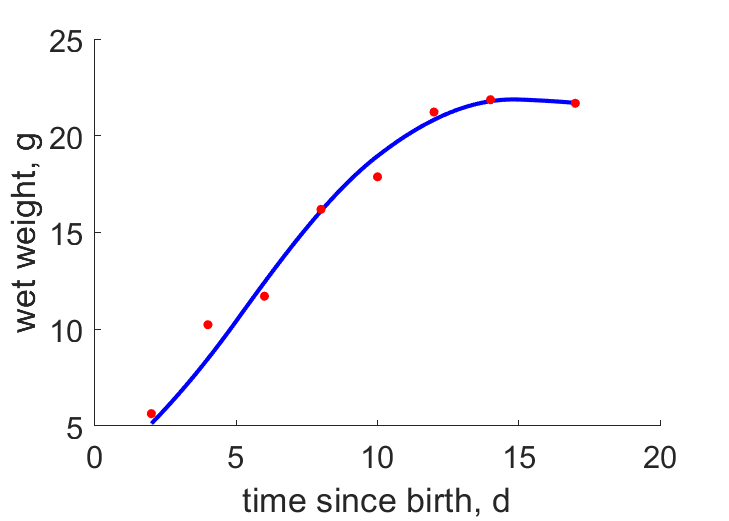Predictions & Data for this entry
| Model: std | climate: A | migrate: | phylum: |
| COMPLETE = 2.5 | ecozone: TN | food: biHs, biCi | class: |
| MRE = 0.021 | habitat: 0iTg, 0iTh | gender: Dg | order: |
| SMSE = 0.001 | embryo: Tnpf | reprod: O | family: |
Zero-variate data
| Data | Observed | Predicted | (RE) | Unit | Description | Reference |
|---|---|---|---|---|---|---|
| ab | 13 | 13.27 | (0.02059) | d | age at birth | guess |
| tx | 17 | 17.03 | (0.001571) | d | time since birth at fledging | ShelGree2014 |
| tp | 51 | 50.17 | (0.01635) | d | time since birth at puberty | guess |
| tR | 365 | 365 | ( 0) | d | time since birth at first brood | guess |
| am | 3650 | 3666 | (0.004269) | d | life span | guess |
| Ww0 | 3.2 | 3.42 | (0.06881) | g | initial wet weight | ShelGree2014 |
| Wwb | 2.5 | 2.427 | (0.02923) | g | wet weight at birth | guess |
| Wwi | 28 | 28.35 | (0.01237) | g | ultimate wet weight | ShelGree2014 |
| Ri | 0.005479 | 0.005441 | (0.006952) | #/d | maximum reprod rate | ShelGree2014 |
Uni- and bivariate data
| Data | Figure | Independent variable | Dependent variable | (RE) | Reference |
|---|---|---|---|---|---|
| tW |  | time since birth | wet weight | (0.03684) | ShelGree2014 |
Pseudo-data at Tref = 20°C
| Data | Generalised animal | Tangara parzudakii | Unit | Description |
|---|---|---|---|---|
| v | 0.02 | 0.04312 | cm/d | energy conductance |
| p_M | 18 | 542 | J/d.cm^3 | vol-spec som maint |
| k_J | 0.002 | 0.02206 | 1/d | maturity maint rate coefficient |
| k | 0.3 | 0.298 | - | maintenance ratio |
| kap | 0.8 | 0.9731 | - | allocation fraction to soma |
| kap_G | 0.8 | 0.8001 | - | growth efficiency |
| kap_R | 0.95 | 0.95 | - | reproduction efficiency |
Discussion
- Body temperature is lower just after hatching
- mod_1: Pseudo-data point k is used, rather than k_J; Data set tp and parameter t_R are added, the latter replacing clutch interval t_N. Postnatal T is based on PrinPres1991, see get_T_Aves. See further the revision page, theme puberty
Bibliography